 Return to
Return toAviation Answer-Man
Gateway
 Return to
Return to
Aviation Answer-Man
Gateway
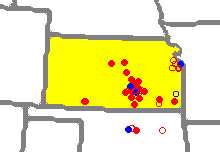 Return to
Return to
Planes on the Plains
Note to the Reader: This is a rough draft release only, for demonstration purposes. There are a few errors which remain to be identified and resolved. Comments and corrections are invited.
(click here)
~RH
_________________________________________
The rapidly rising wealth of Wichita attracted every enterprising, money-hungry character imaginable, including some with really outlandish ways to make money. Among them were the barnstormers: early pilots flying the amazing, newfangled "flying machines." For a respectable price, you could see a human being actually soar through the air like a bird. To the folks of the heartland -- far removed from the many amazing man-made sights of the East -- they were awesome, and crowds flocked to the "air meets" with cash in hand to glimpse the amazing feat of human flight, if only for a moment.
Wichita's first flying exhibition would only be a hint of things to come. It is unlikely that Ely could have imagined that his Kansas performance was to be followed by millions of flights from Sedgwick County soil before the end of the century.
Clyde Cessna
Wichita was a city ripe for building transportation equipment, and had factories or shops for building railroad cars and wagons. Among the city's vehicle makers was J.J. Jones, who had started his personal wealth by selling the newfangled "automobile" to the community's well-heeled. J.J. would soon start manufacturing and selling his own "Jones Six" cars.
While several planes flew in the Oklahoma City show, the one that captivated Clyde Cessna was a French-designed Bleriot monoplane (a single wing, rather than the two wings on most planes -- "biplanes" -- of the day). It was a copy of the Bleriot monoplane with which the French inventor Louis Bleriot, two years earlier, had stunned the world by becoming the first man to fly across the open sea, crossing the English Channel. Cessna was fascinated by the plane, especially when he learned that its pilot had just earned the staggering sum of $10,000 for a three-minute aerial exhibition.
Confident he could build and fly one of these things himself -- and make some REAL money -- Clyde took off for New York to visit the Queens Monoplane company, which was manufacturing copies of the Bleriot monoplane. He rolled up his sleeves and worked there for a month, and learned all he could -- then returned home to Enid with a Queens' monoplane fuselage,
After many disastrous flying starts, and weeks in the hospital, Clyde (at growing cost) kept rebuilding his wrecked airplane, and finally forced the thing to bend to his will -- and the two soon became one. He learned to swoop and soar and twist and turn -- and amazed the local folk who had ridiculed his failed starts. But Enid became too costly. Nearly bankrupted by his pursuit of the sky, Clyde moved his family into a barn on some ancestral lands in Rago, Kansas, a few miles west of Wichita. He promptly began a four-year career as a barnstormer, performing around the Midwest each summer, and building a newer, better plane each winter.
Clyde never got rich. Airplanes were becoming slightly more common, slightly less amazing (but still fascinating), and there was little chance of earning the five-figure paychecks of the pilot whose exhibition first inspired him.
Cessna was fixated on building planes for his own shows, but America joined the First World War, and all exhibition flying was canceled, to divert the nation's resources to the war effort. Clyde switched to building training planes, and managed to crank out the grand total of just four before the war's end.
In 1914, the Old World went to war over European disputes. After two years of bloody stalemate, the U.S. entered the First World War in 1916. Allied victory came in 1918. Though the war had briefly put a damper on most of the nation's civilian life and economy, it had also stimulated a vast new war industry.
Among the Wichita winners was the Coleman Company, whose Coleman lanterns had become the essential sources of heat and light for America's soldiers in the field. The Army's order for 70,000 Coleman lanterns led to a massive growth at Coleman. The company soon filled a four-story factory -- one of the most sophisticated industrial facilities west of the Mississippi River -- which covered half a city block, employing hundreds.
As Wichitans built the Coleman lantern by the tens of thousands, in the First World War, it honed Wichita's familiarity with factories and mass production, and developed a technically-skilled factory labor force, ready for whatever manufacturing opportunities peacetime would bring.
As the war was drawing to a close, Coleman's newly-invigorated company could now begin building millions of his famous lanterns -- bringing light to the darkest corners of rural America, and the world. Far brighter than the smokey, yellow, flickering flame of kerosene lanterns, the Coleman's searing, steady, white light, produced from a tiny amount of clean-burning gasoline (ignited though a net of mineral fibers), could now spread a bright, white light up to a hundred yards away -- for hours.
Until the slow arrival of electricity through "rural electrification" during the 1930's, 40's, and 50's, the Coleman lantern would be the preferred source of light for the one-third of Americans who lived throughout rural America. The brilliant light from Coleman's lanterns would blast away the night from the dark corners of fields, barns and sawmills, and would make possible longer working hours and greater productivity for America's farmers, ranchers, oil drillers, and stonecutters -- bringing more food, fabric, fuel and building materials to market -- accelerating the growth in America's wealth, as the American standard of living came to surpass the rest of the world.
With the successful mastery of mass-production of the complex-but-reliable Coleman lantern, Wichita became a sophisticated manufacturing town, and was braced for far greater technical challenges.
Swallow
In Wichita, a boisterous local oil "wildcatter" named Jake Moellendick (right) had struck it rich -- not by drilling but by supplying and fixing the drilling equipment that Wichita-area oilmen depended upon. He then gambled his money in local wells, and they gushed forth oil and money.
The suddenly wealthy entrepreneur had started a flying service, with the objective of providing himself with an speedy way to zoom from oilfield to oilfield -- not an easy thing in a time of early automobiles, when few roads existed, and far fewer were even paved. But every oilfield usually had a pasture or plowed field nearby, suitable for landing. The Wichita Airplane Company offered rides from a field north of town.
Burke managed to persuade Moellindick and Laird to pool their resources, along with his own, to become partners in Laird's newly-hatched E.M. Laird Airplane Manufacturing Company (which so far was really just selling plans of Laird's design to homebuilders). Moellendick had one demand: Laird had to move his airplane-building project from Chicago to Wichita.
The deal was struck and, in 1920, 23-year-old Laird began completing his light, swift biplanes --
In the United States in 1920, most civilian biplanes were war-surplus trainers that could barely carry the pilot and one passenger. But the Laird biplane's wide front cockpit could carry two (cozy) passengers -- doubling the Laird plane's value for selling rides, and increasing its load for cargo carrying. They soon were named "Swallow" airplanes, befitting their speed and graceful lines. Light, swift, and efficient, the Laird Swallow was a quick success.
Laird brought along his brother, Charles, and a boyhood friend and aviation colleague, George "Buck" Weaver, and later the company hired another young man who had studied architectural engineering before trying to become a naval aviator during the war -- young Lloyd Stearman -- who had not quite finished his flying when the Navy discharged most of its sailors at war's end. Stearman was put on the assembly line, but soon worked his way into engineering activity.
Moellindick, however, was not the easiest guy to get along with. Though Laird was officially company president, Moellendick figured his greater financial investment gave him grounds to meddle constantly in the business -- including hiring a former Army flight instructor named Walter Beech as test pilot, and moving the factory to Wichita's north side while Laird was out-of-town. By 1921, Moellindick had even run off Laird's buddy Buck Weaver -- who returned to the Great Lakes area to start his own Weaver Aircraft Co. -- better known as "WACO," soon one of the most important names in early aviation.
The gentle-mannered young Laird was no match for rich, iron-fisted, pushy old Jake, and Laird eventually took himself and his company name back to Chicago, in 1923, leaving Moellindick to take full control of the Wichita enterprise -- renaming it the "Swallow Airplane Manufacturing Company." Lloyd Stearman, now a draftsman, was elevated to Chief Engineer, and Walter Beech to General Manager. Stearman set about creating a new design, free of obligation to Laird. The resulting speedy New Swallow, which was masterfully streamlined, was a greater hit than any American plane built to date.
By the end of the decade, over 200 Swallows would be used in every aspect of civilian aviation, including the pioneering of commercial American airmail by Varney Air Lines' five early Swallows.
"Swallow" Can't Swallow New Ideas
Although Laird and Moellendick's money-making Swallow airplanes were renowned for their speed and efficiency, they were nearly antiques when built -- since these lightweight, wooden-framed biplanes had not incorporated the latest steel-tube-frame technology that was becoming accepted in military planes.
During the "Great War" (as would happen again in the next "World War") airplane design had evolved rapidly. The light, fragile, wooden-framed, 75-mile-per-hour early planes (with tiny 25-100 horsepower engines) had given way to big, stout, steel-framed beasts (with giant 200-400 horsepower engines) which could blast through the air at well over 120 miles per hour.
Walter Beech, as an Army pilot, had seen these developments up close, and the young engineer Lloyd Stearman understood the logic in them. But Charles Laird and curmudgeonly Old Jake, who ran Swallow Airplane Co. (as it was now called), couldn't bring themselves to abandon a design formula that had made the fabric-skinned, wooden-framed Swallows so light, fast and successful.
So in the 1920's, Walter Beech and Lloyd Stearman -- determined to build "modern" airplanes -- abandoned Swallow, to start their own airplane-building company. Wichita was a wealthy town, with money to lend to daring new adventures, so the idea wasn't too far-fetched. The duo turned to the only other airplane-builder in the area, Clyde Cessna (who had begun making money winning airplane races with his own refined planes), and invited Cessna to join them as president of their new Travel Air Manufacturing Company. Over the next few years, Beech, Cessna and Stearman would quickly build Travel Air into the foremost lightplane maker in America. By 1929, over a quarter of all the planes built in America would be Travel Airs.
Copying a key aspect of the Swallow's design, the Travel Air's wide front cockpit could carry two (cozy) passengers. As with the Swallow, this doubled the plane's value (over competing planes) for selling rides, and increased its load for cargo-hauling. Pulled through the sky by the very biggest and best light-plane engines that money could buy, the fast Travel Airs were free of the cumbersome, sluggish performance typical of the primitive planes of their day.
The world's wealthy -- and its professional aviators -- beat a path to Travel Air's door to buy its outstanding planes.
But the Travel Air design was limited. Its biplane configuration wasn't as efficient as the monoplane, and Clyde Cessna knew it. The tangle of wires and struts that gives the biplane its structural rigidity and strength also leaves a lot of hardware hanging out there, dragging in the breeze, slowing down the plane.
And every wing generates its own drag -- every wingtip in particular. As the high-pressure air under the wing spirals up around the wingtip to join the low-pressure air above, it twists into an invisible little horizontal tornado dragging behind the wingtip, and pulling on the plane. Biplanes have four of these "induced-drag vortices" -- one for each wingtip. Monoplanes only have two.
Clyde Cessna, who'd started out with monoplanes, and had even set a national speed record with one, knew how much more efficient and speedy they could be. And in the 1920's, when major airplane races were as big a national event as today's Superbowl (no kidding), speed was everything. A winning airplane could bring fame and fortune to its maker.
Conservative vs. Creative
Cessna however, could not get Walter Beech to see the sense of monoplanes. So Cessna set about building one on his own time, in a private shop. The result was a high-wing, 4-seat, enclosed-cabin monoplane. When Cessna was finished, he showed Beech the plane's surprising capacity and efficiency, and Beech relented -- letting a few be built at Travel Air -- giving rise to the Travel Air 5000 series.
The production models were refined somewhat from Cessna's original design to meet a specification from National Air Transport, one of the nation's first airlines, which wanted a comfortable transport for it's executive clientele, which would nevertheless be fast and efficient. The resulting product became the first airliner ever built to the specifications of a customer airline, and would shape the way in which key American airliner developments would happen over the rest of the century.
The speedy, efficient Model 5000 Travel Airs, like the "Oklahoma" (above), soon became prized as long-distance racers, and a young mailplane pilot approached Walter Beech to see if he could use one to try and fly across the ocean to win a prize. Though the Atlantic Ocean had been crossed by various teams of flyers, mostly in seaplanes, taking the shortest possble hops, no one had yet flown nonstop all the way from New York to Paris, and this young man thought he could make the 36-hour flight all by himself, in a Travel Air monoplane.
But Walter Beech, a conservative and realistic man sent the young fool on his way. So the young man, Charles Lindbergh, went to the Ryan monoplane company instead... and the rest is not Wichita history.
Stearman Strikes Out on His Own
By late 1926, Lloyd Stearman had quit Travel Air, to run off to California in search of a chance to start building biplanes similar to those he'd designed at Travel Air. Travel Air's California dealer, Fred Hoyt, a friend of Stearman's, persuaded him there was real money to be made selling airplanes to the Hollywood movie studios, who were using them up frantically in movies -- complete with crash scenes. Hoyt offered to foot much of the bill to start production in California, and the fast-rising young Stearman saw this as the natural next rung on his ladder of success.
Stearman packed up his family and headed West. On October 1, 1926, Stearman Aircraft Company went into business in the town of Venice, California, near Hollywood. But by the time that his first biplanes were coming off the line, movie audiences had suddenly shifted away from their fascination with airplanes to a fascination with cowboys -- and the market for movie airplanes vanished.
Wichita investor Walter P. Innes, Jr., who had been one of Travel Air's founding financiers, and its first president, phoned young Stearman the following year, and learned of his plight. Innes persuaded him to return to Wichita, where Innes rounded up 60 local businessmen and got them to invest in the relocation of Stearman's company to Wichita.
The company set up in the old Burton Car Works factory, where -- 11 years earlier -- Clyde Cessna had built the first airplane that Lloyd Stearman had ever seen fly.
The beginning was as prosperous as it was auspicious. Young Stearman's big, stout biplanes would start earning their keep as touring machines, and as "mailplanes" -- delivering the newly-popular "air mail." Sturdy and reliable, and capable of enduring heavy, daily flying schedules in extremes of weather, the Stearmans earned a reputation as tough, safe and reliable planes -- essential for airmail service. And the orders rolled in...
Cessna Flees, Flies
Meanwhile across town, at the big Travel Air factory on Wichita's east side, the biplane/monoplane controversy was still raging between Walter Beech and Clyde Cessna.
Cessna -- determined to build his unbraced "cantilever" wing -- quit Travel Air, and started his own enterprise: Cessna Aircraft Company. Before the end of the century, it would become the highest-volume producer of aircraft in the world. But that's jumping ahead.
By early 1929, Cessna had produced his slim, streamlined, 4-seat, enclosed-cabin "Model A" monplane (the most popular version was the Warner-engined "Cessna AW").
With the Cessna Model A offering the best performance for the dollar, a string of orders were rapidly piling up. The president of a large flight-training company offered to sell Cessna's planes, if Cessna would commit to building dozens a month. Cessna sold off controlling interest in his company to raise the money for expansion, and began the first mass-manufacture of Cessna airplanes -- a brand of planes that would eventually come to outnumber all other brands in the world.
Every Man a Manufacturer
Throughout the late 1920's and early 1930's, other would-be aviation entrepreneurs quit Swallow or Travel Air, too, to start their own airplane-building enterprises -- and others rose up from the surrounding community. Yunkers, Miller, Russell Holmes, Felix Knoll, Ralph Hilton (with Harvey Brown), Simeon Beach (no relation to Walter Beech) all started their own plane-building enterprises, sometimes with respectable-sized factories. Another group started Lark Aircraft (later United Aircraft -- neither company related to subsequent companies of the same name).
By 1929, it was the peak of the bullish "Roaring Twenties," when the skyrocketing stock market implied that every bold venture was a great idea. With Wichita awash in money and airplane-building talent, starting an company which built and sold high-priced flying machines seemed like a logical -- even clever -- investment.
By mid-1929, a map of Wichita, with big, red dots showing all the airplane factories of the last three years, would have looked like a pepperoni pizza. Several small airplane factories had sprung up along or near Douglas Avenue west of the river, along the route that only a couple of generations earlier had been host to cattle herds and gunfights. Typically, these outfits produced little more than one or two planes, but a few managed to produce a handful of flying machines. A few dozen planes actually resulted from these various obscure, short-lived ventures.
But one more venture would last, and become legend. It would be the enterprise of the young mechanic-turned-draftsman-turned engineer who had designed the popular New Swallow and some of Travel Air's classics -- Lloyd Stearman.
Travel Air Flies On
Back at Travel Air, the efficient 5-6 seat Travel Air 5000 and 6000 monoplanes, which Clyde Cessna had designed, were winning races -- especially endurance and distance races -- including the famous Dole Pineapple race to Hawaii, across the Pacific Ocean, won by a Travel Air 5000 named "Woolaroc."
Walter Beech finally came to concede that monoplanes were, indeed, the racing planes of the future. And since race victories were essential for the credibility of a 1920's plane maker, Beech secretly built a racing monoplane: the sleek, compact Travel Air 'Mystery Ship' (left) -- fastest pylon-racing plane in America at the time -- powered by a 425-horsepower Wright radial engine, and streamlined with the first fully streamlined "NACA" engine cowling and first streamlining "wheel pants" on a civilian airplane.
Appearing at the National Air Races in Cleveland, Ohio, in 1929, to the surprise of the U.S. Army and Navy, the sleek, fast Mystery Ship roared to victory at an average speed of 195 mph, and a top speed of 208 mph -- becoming the first civilian plane ever to beat the military's high-powered biplane fighters in a major race. It caused a national uproar, with the public demanding a better-prepared military. That victory signaled the end of the era of the biplane as a weapon of war, and military forces around the world began switching to the development and acquisition of monoplane designs.
But the victories were not enough to enable Travel Air to survive the coming catastrophe, which would engulf the nation, and Wichita's other plane makers, as well: The Great Depression...
For the rest of the story, stay tuned.
There's more to come next month, including stories of the Great Depression, World War II, the Cold War, and other events. Travel Air, Cessna, Beech, Stearman, Boeing (Wichita built most of Boeing's biggest bombers) Mooney,
The
"Air Capital of the World"
isn't where you'd expect.
Chapter 3
Here Come those Magnificent Men
& Their Flying Machines
Copyright 2002 by Richard Harris
All Rights Reserved
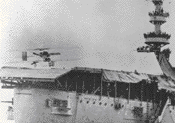 The first "air meet" held in the Wichita area was in 1911, in a pasture north of town. The first plane to fly from the Sedgwick County soil was a Curtiss Pusher biplane, piloted by the daring pioneer aviator Eugene Ely -- who had just initiated the very first sea-going aircraft carrier into service, in January, by successfully landing his Curtiss plane on the converted deck of the battleship Pennsylvania (right), and then taking off from it hours later.
The first "air meet" held in the Wichita area was in 1911, in a pasture north of town. The first plane to fly from the Sedgwick County soil was a Curtiss Pusher biplane, piloted by the daring pioneer aviator Eugene Ely -- who had just initiated the very first sea-going aircraft carrier into service, in January, by successfully landing his Curtiss plane on the converted deck of the battleship Pennsylvania (right), and then taking off from it hours later.
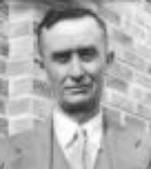 And another vehicle-maker was an employee of J.J.'s who had run J.J.'s auto dealership branch in another oil-boom, Enid, Oklahoma, 80 miles to the south. That employee, a farmer-handyman, turned car salesman, named Clyde Cessna (left), first saw an airplane in 1911, at a fair in Oklahoma City -- yet another oil-boom town.
And another vehicle-maker was an employee of J.J.'s who had run J.J.'s auto dealership branch in another oil-boom, Enid, Oklahoma, 80 miles to the south. That employee, a farmer-handyman, turned car salesman, named Clyde Cessna (left), first saw an airplane in 1911, at a fair in Oklahoma City -- yet another oil-boom town.
 and began building wings, tail and landing gear for it -- and modifying a motorboat engine to power it.
and began building wings, tail and landing gear for it -- and modifying a motorboat engine to power it.
 But Cessna's old boss, J.J. Jones, was willing to sponsor the flyer, letting Cessna use the Jones car factory in Wichita (formerly the Burton Stock Car Co. factory, left)
But Cessna's old boss, J.J. Jones, was willing to sponsor the flyer, letting Cessna use the Jones car factory in Wichita (formerly the Burton Stock Car Co. factory, left)
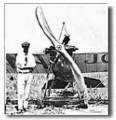 to build his airplanes -- in exchange for the notoriety that was expected to attach to Jones' cars when coming from the same factory as an airplane. So Clyde Cessna set up shop in a corner of the Jones factory, and began painting "Jones" in giant letters on the wings of his airplanes.
to build his airplanes -- in exchange for the notoriety that was expected to attach to Jones' cars when coming from the same factory as an airplane. So Clyde Cessna set up shop in a corner of the Jones factory, and began painting "Jones" in giant letters on the wings of his airplanes.
 War & Wichita
War & Wichita

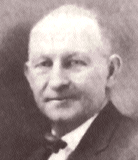
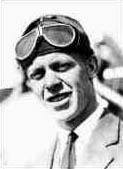 To run the enterprise, Moellindick had hired Billy Burke, a friend from Oklahoma who had run an aerial exhibition team as a sideline to his automotive business. Burke had recently met a young Chicago-area flyer/airplane-builder named Emil Matthew "Matty" Laird (left), one of America's early "barnstorming" exhibition pilots.
To run the enterprise, Moellindick had hired Billy Burke, a friend from Oklahoma who had run an aerial exhibition team as a sideline to his automotive business. Burke had recently met a young Chicago-area flyer/airplane-builder named Emil Matthew "Matty" Laird (left), one of America's early "barnstorming" exhibition pilots.
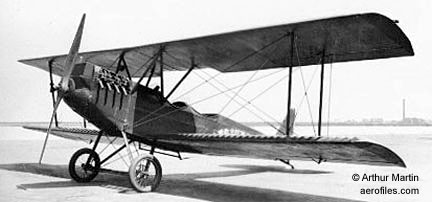 the first successful, commercially-manufactured planes in America -- in a downtown shop near the river crossing where, only a generation and half before, cattle herds had entered town. The first commercially-produced planes available in America, the Laird Swallow biplanes were instantly in demand.
the first successful, commercially-manufactured planes in America -- in a downtown shop near the river crossing where, only a generation and half before, cattle herds had entered town. The first commercially-produced planes available in America, the Laird Swallow biplanes were instantly in demand.
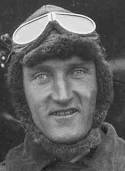
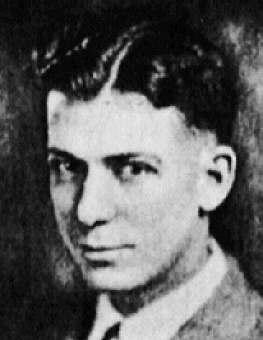 The fate of American general aviation now hung largely in the hands of two men: a wartime Army flight instructor named Walter Beech (left), who had become a consummate salesman for Swallow, and a young architecture student, turned Navy airplane rigger, turned pilot/engineer -- named Lloyd Stearman (right).
The fate of American general aviation now hung largely in the hands of two men: a wartime Army flight instructor named Walter Beech (left), who had become a consummate salesman for Swallow, and a young architecture student, turned Navy airplane rigger, turned pilot/engineer -- named Lloyd Stearman (right).
2.jpg) The Travel Air Success Formula:
The Travel Air Success Formula:
Big, Slick, Steel Biplanes
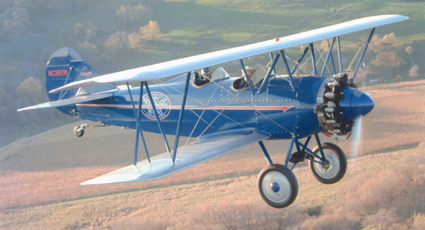 The formula for the Travel Air success was simple: big engines, stout, steel-framed biplanes (still wrapped in lightweight cloth "skin" like all other planes of the day), and streamlining (where possible). The rugged, fast Travel Airs soon earned a reputation as the King Kong of lightplanes, and as the ultimate personal traveling machine.
The formula for the Travel Air success was simple: big engines, stout, steel-framed biplanes (still wrapped in lightweight cloth "skin" like all other planes of the day), and streamlining (where possible). The rugged, fast Travel Airs soon earned a reputation as the King Kong of lightplanes, and as the ultimate personal traveling machine.



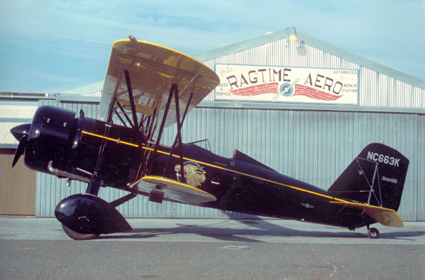 Nearly a year to the day after he'd set up shop in California, Stearman's company was re-incorporated in Wichita. (The community leaders' gamble would eventually yield the biggest employer in the state of Kansas, for 50 years -- though not under the Stearman name.)
Nearly a year to the day after he'd set up shop in California, Stearman's company was re-incorporated in Wichita. (The community leaders' gamble would eventually yield the biggest employer in the state of Kansas, for 50 years -- though not under the Stearman name.)

 Cessna was more daring than Walter Beech, and determined to see the monoplane thing all the way through to the finish line. Though Beech had let Cessna's strut-braced monoplane become a Travel Air product (the Model 5000), he stubbornly refused to go all the way with Cessna's next idea: getting rid of the wing-support struts, for a cleaner, faster plane. Walter Beech, who'd been a wartime pilot, flying military biplanes, knew how much the strength of wings depended upon their extensive external bracing. He refused to give up wing struts.
Cessna was more daring than Walter Beech, and determined to see the monoplane thing all the way through to the finish line. Though Beech had let Cessna's strut-braced monoplane become a Travel Air product (the Model 5000), he stubbornly refused to go all the way with Cessna's next idea: getting rid of the wing-support struts, for a cleaner, faster plane. Walter Beech, who'd been a wartime pilot, flying military biplanes, knew how much the strength of wings depended upon their extensive external bracing. He refused to give up wing struts.
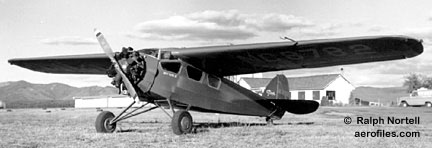 The cantilever-winged plane -- devoid of external bracing -- was, indeed, fast and efficient for its time and engine size. In spite of its clean lines, the wing was stout -- so stout that Clyde lined up men across the top of the wing to prove it needed no external bracing. Clyde and his colleagues promptly won several races with it. In particular, the AW was winning efficiency races -- going farther and faster on a modest-sized engine than many planes with much larger, more-expensive, more-thirsty engines.
The cantilever-winged plane -- devoid of external bracing -- was, indeed, fast and efficient for its time and engine size. In spite of its clean lines, the wing was stout -- so stout that Clyde lined up men across the top of the wing to prove it needed no external bracing. Clyde and his colleagues promptly won several races with it. In particular, the AW was winning efficiency races -- going farther and faster on a modest-sized engine than many planes with much larger, more-expensive, more-thirsty engines.

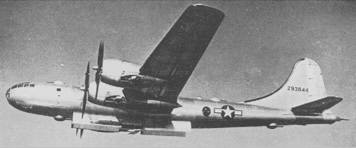
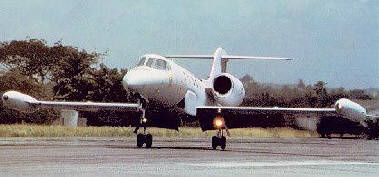 LearJet, America's first jet ace, the Thunderchief fighter-bombers and Titan nuclear missiles of McConnell Air Force Base, Wichita's contributions to the space program, the National Institute for Aviation Research, stunt planes, record-breaking helicopters, the world's fastest civilian plane made today, and more! As World War II leads Wichita plane-makers to spread their growth out into the small towns of Kansas and Oklahoma, see how a "nowhere" town becomes the center of aviation progress. See you next month!
~RH
LearJet, America's first jet ace, the Thunderchief fighter-bombers and Titan nuclear missiles of McConnell Air Force Base, Wichita's contributions to the space program, the National Institute for Aviation Research, stunt planes, record-breaking helicopters, the world's fastest civilian plane made today, and more! As World War II leads Wichita plane-makers to spread their growth out into the small towns of Kansas and Oklahoma, see how a "nowhere" town becomes the center of aviation progress. See you next month!
~RH

 Return to
Return to
Planes on the Planes
Introduction
 Return to
Return to
Aviation Answer-Man
Gateway